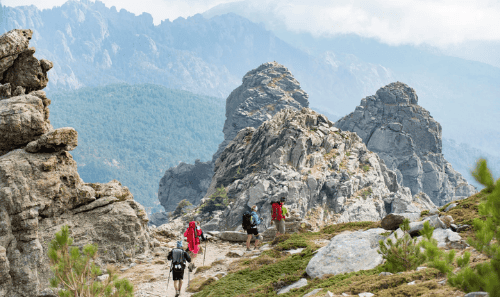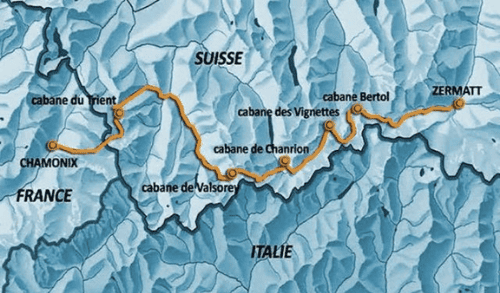So You Think You're Tough?
Good. Because these trails don’t care. Europe may be full of charming cafés, wine regions, and romantic sunsets, but here we’re talking about the most challenging hikes in Europe, so we’re heading the opposite direction—straight into wild terrain, unpredictable weather, and brutal climbs.
These hikes will chew up your boots, melt your legs, and possibly your soul. But if you’re up for the challenge (and slightly masochistic), they’ll also reward you with views that make all the pain worth it.
This isn’t just about showing off your fancy gear on Instagram. This is about raw, real, no-handrails adventure. Ready? Let’s dive in.
The Top 10 Most Challenging Hikes in Europe:
1. GR20, Corsica, France
“The Beast of the Mediterranean”
Why it's a tough Hike:

- Distance: ~180 km
- Time: 12–16 days
- Elevation Gain: ~12,000 m
- Difficulty: 5/5 – Brutal and Unforgiving
- What to look out for: Intense heat, exposed scrambling, rocky terrain, limited water sources
How to prepare for this tough hike:
2. Monte Rosa Tour, Switzerland/Italy
“Alpine Eye Candy, Glacier Edition”
Why it's a tough Hike:
How to prepare for this tough hike:
Train at altitude if you can. If not, go hard on endurance and leg strength. Learn how to use crampons without stabbing yourself or your hiking buddy. If you’re new to glacier travel, seriously—consider a mountaineering course. Get comfortable with cold mornings, unpredictable weather, and carrying gear that makes you look like a snow ninja. The views? Absolutely worth it. But this hike demands respect—and a solid pair of lungs.

- Distance: ~165 km
- Time: 9–12 days
- Elevation Gain: ~10,000 m
- Difficulty: 4.5/5 – High, Cold, and Serious
- What to look out for: Glacier crossings, altitude sickness, rapid weather changes
3. Haute Route, Chamonix to Zermatt
“The Scenic Route to Suffering”
Why it's a tough Hike:

- Distance: ~200 km
- Time: 10–14 days
- Elevation Gain: ~14,000 m
- Difficulty: 5/5 – High Alpine Hardcore
- What to look out for: Glaciers, snowfields, steep climbs, unpredictable weather
How to prepare for this tough hike:
4. Via delle Bocchette, Dolomites, Italy
“Don’t Look Down, Just Keep Moving”
Why it's a challenging hike:

- Distance: ~30–50 km
- Time: 4–5 days
- Elevation Gain: ~3,500 m
- Difficulty: 4.5/5 – Don’t Slip, Don’t Panic
- What to look out for: Narrow ledges, exposed via ferrata routes, sheer drops
How to prepare for this challenging hike:
5. The Eagle Walk (Adlerweg), Austria
“Long, Lovely, and Legs of Steel Required”
Why it's a tough hike:
How to prepare for this tough hike:
Train for long-distance hikes with big elevation gains. Back-to-back hiking days are your new best friend. Build serious leg and lung power, and get savvy with trekking poles—they’ll save your knees on the descents. Learn to read mountain weather like your life depends on it, because sometimes it kinda does. Bonus points if you can yodel well enough to scare off marmots (or at least entertain your hiking crew).

- Distance: ~320 km
- Time: 24 stages
- Elevation Gain: ~23,000 m
- Difficulty: 4/5 – Long-Distance Leg Burner
- What to look out for: Long daily climbs, rapid weather changes, remote sections
6. Skye Trail, Scotland
“Where the Trail Doesn’t Exist (But the Rain Does)”
Why it's a challenging hike:

- Distance: ~128 km
- Time: 7–10 days
- Elevation Gain: ~4,800 m
- Difficulty: 4/5 – Off-Grid and Wild
- What to look out for: No trail markings, bogs, strong winds, challenging navigation
How to prepare for this challenging hike:
7. Trolltunga via Ferrata, Norway
“Straight Up Into the Clouds”
Why it's a challenging hike:

- Distance: ~20 km round trip
- Time: 10–12 hours
- Elevation Gain: ~1,200 m
- Difficulty: 3.5/5 – Vertical Day of Doom
- What to look out for: Long vertical climb, steel cables, sudden weather shifts
How to prepare for this challenging hike:
8. Laugavegur + Fimmvörðuháls, Iceland
“Lava, Snow, and a Whole Lot of Wind”
Why it's a challenging hike:
How to prepare for this challenging hike:
Train in bad weather—seriously. Get used to hiking through wind, rain, and cold. Build solid cardiovascular endurance and practice river crossings (yes, your feet will get wet). Layer like a pro and pack gear that can handle all four seasons in one afternoon. Most of all, embrace the wild. This hike isn’t about control—it’s about keeping up with nature’s mood swings.

- Distance: ~80 km
- Time: 4–6 days
- Elevation Gain: ~2,500 m
- Difficulty: 3/5 – Weather Warrior Needed
- What to look out for: Snow, lava fields, river crossings, constant weather changes
9. Kungsleden (North), Sweden
“Silence, Solitude, and Sore Feet”
Why it's a challenging hike:

- Distance: 450
- Time: 10–14 days
- Elevation Gain: ~1,800 m
- Difficulty: 3/5 – Remote and Relentless
- What to look out for: Isolation, river crossings, cold weather, mosquitoes
How to prepare for this challenging hike:
10. Rota Vicentina, Portugal
“Sunburn and Sand for Days”
Why it's a challenging hike:
How to prepare for this challenging hike:
Train in heat and on soft, shifting terrain. Strengthen your calves and core—they’ll take the brunt of the sand shuffle. Carry more water than you think is reasonable, and invest in proper sun protection (hat, SPF, long sleeves, the whole survival-in-the-desert starter pack). It’s less “technical challenge” and more “mental marathon,” so come prepared to sweat—and keep moving.

- Distance: ~230 km
- Time: 2–3 weeks
- Elevation Gain: ~3,500 m
- Difficulty: 3/5 – Endurance in the Heat
- What to look out for: Heat exhaustion, sand fatigue, little shade, scarce water
How to Prepare for Long-Distance challanging Hikes in general?
Want to take on long-distance, tough hikes like these? Here’s your no-BS crash course to surviving (and maybe even enjoying) the grind:
- Leg Day: LifeSquats, lunges, hill repeats—do them all, and then do them again. Your legs are your engine, and these trails? They don’t take it easy on them.
- Backpack Training: Hike with weight before your trip. Get used to your pack, your straps, and the way your shoulders will cry a little at first. And if you want to avoid rookie mistakes, check out our guide on How to Pack Your Backpack Like a Pro: Comfort and Efficiency — because a badly packed bag can ruin a good trail fast.
- Endurance, Endurance, Endurance: Start with long hikes on weekends, then stack them back-to-back. You need to know what “tired on day two” feels like before you’re five days deep with no exit in sight.
- Weather-Proof Yourself: Rain, wind, cold, heat—train in all of it. Get comfortable being uncomfortable, because the mountains don’t care about your ideal forecast.
- Navigation & Safety: Know how to use a map and compass without needing Wi-Fi. (Need one? This reliable hiking compass is a great place to start.) Take a basic first aid course. Most importantly: know your limits, and respect them. These hikes are incredible, but they don’t come with guardrails.
Ready to go?
What are the hardest hikes in Europe?
Europe’s hardest hikes include the GR20 in Corsica, the Haute Route in the Alps, and via ferrata routes like Via delle Bocchette in Italy. These trails are known for steep climbs, technical terrain, and extreme weather conditions.
How should I prepare for a challenging multi-day hike?
Build endurance, train with a loaded backpack, hike in rough terrain and bad weather, and learn basic navigation and safety skills.
Are there high-altitude hiking trails in Europe?
Yes! Several alpine routes like the Haute Route, Monte Rosa Tour, and Eagle Walk climb above 2,500–3,000 meters and require acclimatization.
What gear do I need for extreme hiking in Europe?
Depending on the trail: sturdy hiking boots, layered clothing, trekking poles, navigation tools, and in some cases, via ferrata gear or glacier equipment. Ready for pain, views, and bragging rights? If these trails light a fire in your soul (or your quads), you’re in the right place. Pack well, train smart, and remember: the toughest trails bring the biggest rewards. Enjoyy:)
Want something a little easier first? Check out our guide to the best beginner hikes in Europe.




